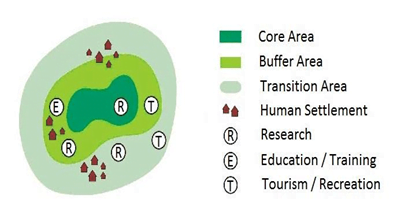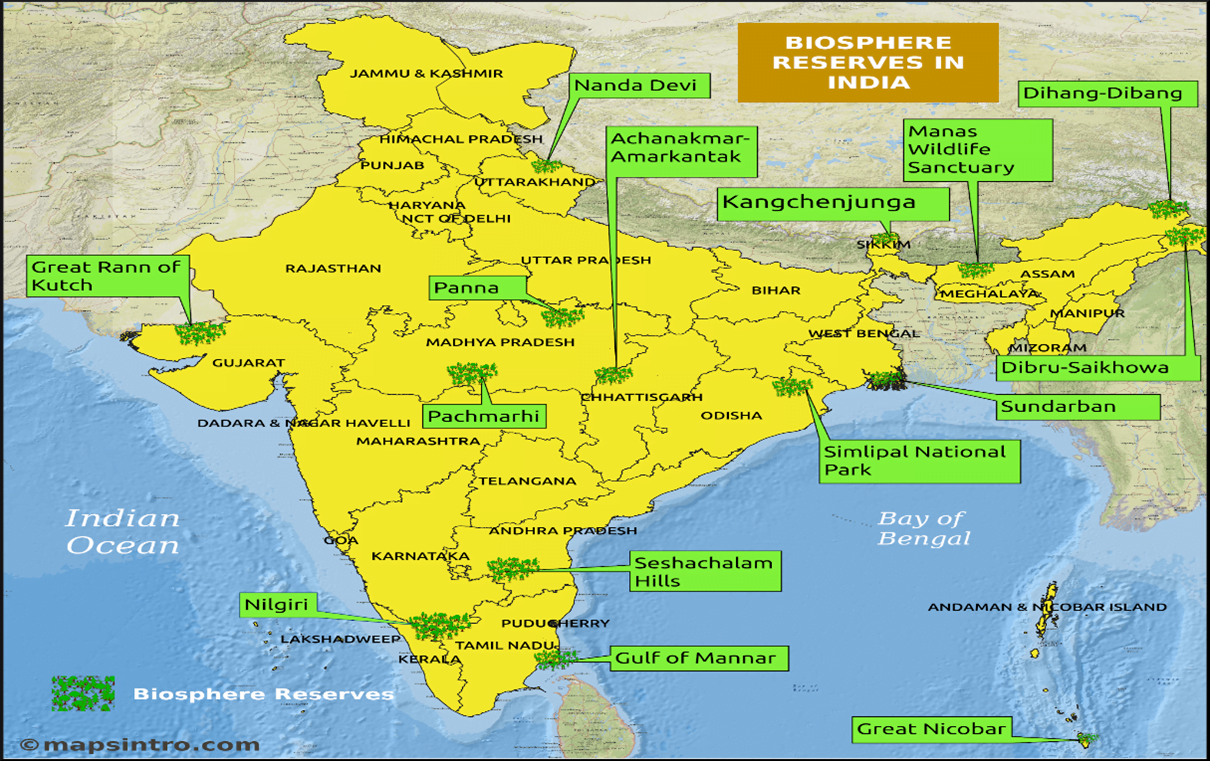Economics, Environment & Ecology
Context: Since from 2022, November 3 is celebrated as ‘The International Day for Biosphere Reserves’.
About World Network of Biosphere Reserves:
- The UNESCO World Network of Biosphere Reserves (WNBR) was formed in 1971.
- WNBR covers internationally designated protected areas, known as biosphere reserves, which are meant to demonstrate a balanced relationship between people and nature (e.g., encourage sustainable development).
- They are created under the Man and the Biosphere Programme (MAB).
- All biosphere reserves are internationally recognised sites on land, at the coast, or in the oceans.
- There are 738 biosphere reserves in 134 countries, including 22 transboundary sites. They are distributed as follows:
- 90 sites in 33 countries in Africa
- 36 sites in 14 countries in the Arab States
- 172 sites in 24 countries in Asia and the Pacific
- 308 sites in 41 countries in Europe and North America
- 132 sites in 22 countries Latin America and the Caribbean.
Nomination & approval of biosphere reserves:
- Governments alone decide which areas to nominate.
- Before approval by UNESCO, the sites are externally examined.
- If approved, they will be managed based on a plan, reinforced by credibility checks while remaining under the sovereignty of their national government.
Functions of Biosphere Reserves:
- Biosphere Reserves involve local communities and all interested stakeholders in planning and management. They integrate three main “functions”:
- Conservation of biodiversity and cultural diversity
- Economic development that is socio-culturally and environmentally sustainable
- Logistic support, underpinning development through research, monitoring, education and training.
Structure of Biosphere Reserve:

They are demarcated into the following 3 interrelated zones:
Core Zone:
- Includes protected areas, as they act as reference points on the natural state of the ecosystems represented by the biosphere reserves. Have endemic species of plants & animals.
- A core zone is a protected region, like a National Park or Sanctuary/protected/regulated mostly under the Wildlife (Protection) Act, 1972.
- It is kept free from human interference.
Buffer Zone:
- The buffer zone surrounds the core zone and its activities are managed in this area in ways that help in the protection of the core zone in its natural condition.
- It includes restoration, limited tourism, fishing, grazing, etc; which are permitted to reduce its effect on the core zone.
- Research and educational activities are to be encouraged.
Transition Zone:
- It is the outermost part of the biosphere reserve. It is the zone of cooperation where human ventures and conservation are done in harmony.
- It includes settlements, croplands, managed forests and areas for intensive recreation and other economic uses characteristics of the region.
Biosphere Reserves in India:

Need for expansion:
- According to the Global Assessment Report on Biodiversity and Ecosystem Services released in 2019 by the Intergovernmental Science-Policy Platform on Biodiversity and Ecosystem Services (IPBES), the main global drivers of biodiversity loss are:
- Climate change,
- Invasive species,
- Over-exploitation of natural resources,
- Pollution and
- The ecological carrying capacity of planet earth has largely been exceeded because of our collective excesses.
- Therefore, the need was felt to address this trend with cleaner air, high-quality drinking water, and enough food and healthy habitats to ensure that ecosystem services continue to benefit humanity without critically affecting nature’s balance.
Way Forward:
- The ‘South and Central Asia MAB Reserve’ Networking Meeting (where MAB stands Man and the Biosphere) is planned for 2023, to advance biosphere reserve establishment and management.
- In addition, an expert mission has been planned for spring 2023 — to Bhutan, India’s north-east and the Sundarbans in Bangladesh.
With at least one biosphere reserve per country in Bangladesh, Bhutan and Nepal until 2025 (with additional biosphere reserves in India’s North-East and along the coasts) it will give realisation to millions of people that a better future is truly possible — one where we will truly live in harmony with nature.
Source: The Hindu












